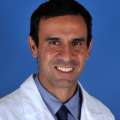In July 2014, Officer Eric Holtz of the Los Angeles Police Department was riding his motorcycle in Van Nuys when a vehicle made a U-turn in front of him. Holtz collided with the rear of the vehicle and was thrown from his bike and over the vehicle, landing on his right side. He suffered bruises and soreness but no broken bones. But as the months went by, Holtz began to notice a shortness of breath, especially when he exercised. He didn’t connect the accident with his symptoms. “I thought it was age-related,” says Holtz, who now is 48.
Then, in December 2015, Holtz went to an urgent care facility for what he thought was a severe cold. Instead, a chest X-ray revealed that his diaphragm and right lung were paralyzed. The doctor told him he had a phrenic nerve injury. As a husband and father of three, he worried about how this condition would affect his family and his career.
The phrenic nerves, which originate in the neck and pass between the lung and heart to reach the diaphragm, transmit signals from the brain and spinal cord to cause the diaphragm to contract, resulting in expansion of the chest cavity and drawing of air into the lungs. Each year, approximately 5,000-to-10,000 Americans suffer an injury to their phrenic nerve, but many may not be aware of it. Neither may their doctors; the condition can be hard to diagnose. Though damage to the phrenic nerves is not always immediately apparent, the resulting scar tissue can, over time, compress the nerves.
Concerned that his physical condition might require him to take a desk job, or even early retirement, Holtz searched for a solution, finding UCLA Health’s phrenic nerve program, which offers reconstructive surgery specifically to repair the paralyzed diaphragm. Even more promising, a 2016 UCLA study had shown that 89 percent of patients who underwent phrenic nerve repair surgery had significant improvement in breathing and an increase in regular physical activities.
Holtz underwent the 2½-hour surgery at UCLA in October 2016. The surgery was performed by Reza Jarrahy, MD (FEL ’06), associate clinical professor of plastic and reconstructive surgery, and Matthew Kaufman, MD, a New Jersey surgeon who regularly volunteers as assistant clinical professor at the David Geffen School of Medicine at UCLA to team up with Dr. Jarrahy for the specialized procedure.
Together, they removed the scar tissue around the injured right phrenic nerve in Holtz’s neck. Then they took a nerve from Holtz’s right leg to use as a bypass around the injured area, creating a clear route for the nerve signal from the brain to the diaphragm. After that, the wait began for the new nerve to regrow and form connections in the body, a process that can take a year or more.
“During this time, patients are encouraged to maintain a pulmonary rehabilitation program, including cardiovascular exercise to rebuild the diaphragm muscle,” Dr. Jarrahy says. “Also, a physical therapist with specialty training can help with diaphragm retraining to strengthen the muscle.”
Before surgery, Holtz felt light-headed after jogging just one minute. But six months post-surgery, he was able to slowly run a couple of miles without noticing any breathing problems. With his recovery well underway, he’s happy that he did his research and found treatment. Now, he can continue his career as a motorcycle officer.
